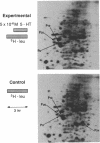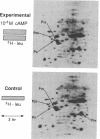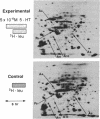Abstract
To identify proteins that may be involved in the induction of long-term changes in the nervous system, we investigated whether specific proteins in pleural sensory neurons of Aplysia were affected by procedures that mimic those used to produce long-term sensitization. Using two-dimensional PAGE, we found that exposure to serotonin (5-hydroxytryptamine, 5-HT) for 2 or 3 hr appeared to increase incorporation of labeled amino acids into one protein (P9) and decrease incorporation into two other proteins (P19 and P20). These effects of 5-HT were observed whether the labeled amino acid was leucine or methionine. The same proteins that were affected by 5-HT were also altered by the adenylate cyclase activator forskolin and by the 8-bromo and 8-benzylthio analogs of cAMP. Addition of Co2+ to 5-HT did not seem to affect the action of 5-HT on P9 and P20, but it did seem to block the effect of 5-HT on P19. However, the effect of analogs of cAMP on P9, P19, and P20 was not altered by inclusion of Co2+. A phorbol ester that activates protein kinase C did not appear to affect the proteins that were modified by 5-HT, but phorbol ester did appear to increase the amount of labeled amino acids incorporated into another protein (P24). To investigate the specificity of these effects for pleural ganglion neurons, we examined the effect of 3- and 6-hr treatments of 5-HT on proteins in the abdominal ganglion. 5-HT affected at least nine proteins in the abdominal ganglion. One of these proteins (P9) appeared to be the same as one altered by 5-HT in the pleural sensory neurons. However, the occurrence of some proteins and some effects of 5-HT were specific for one ganglion or the other. The identified proteins that were affected by both 5-HT and changes in cAMP may be involved in the induction of long-term changes in the nervous system of Aplysia.
Full text
PDF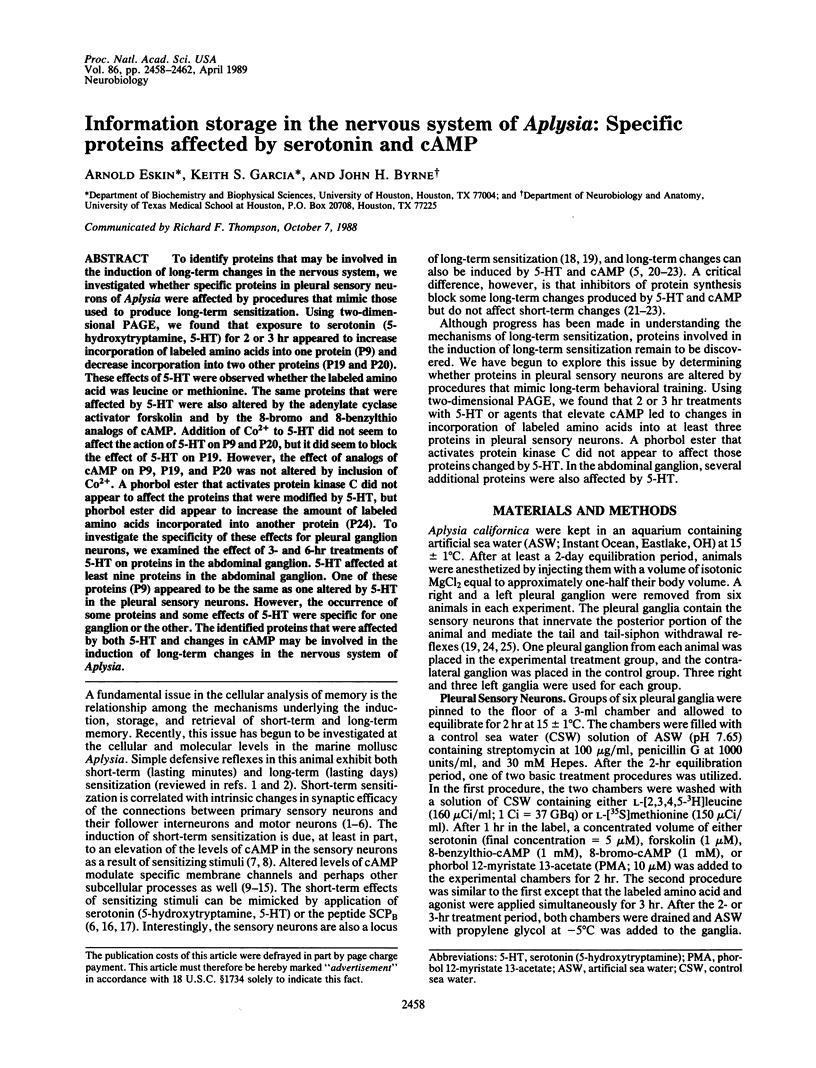
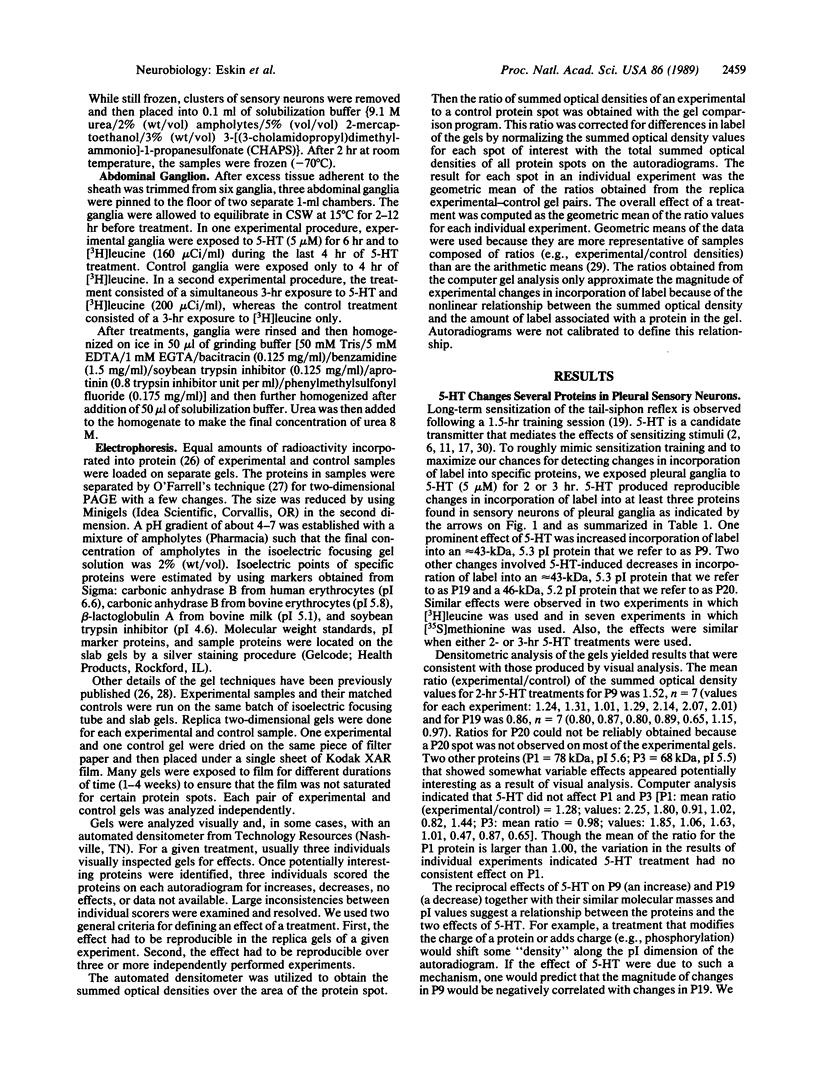
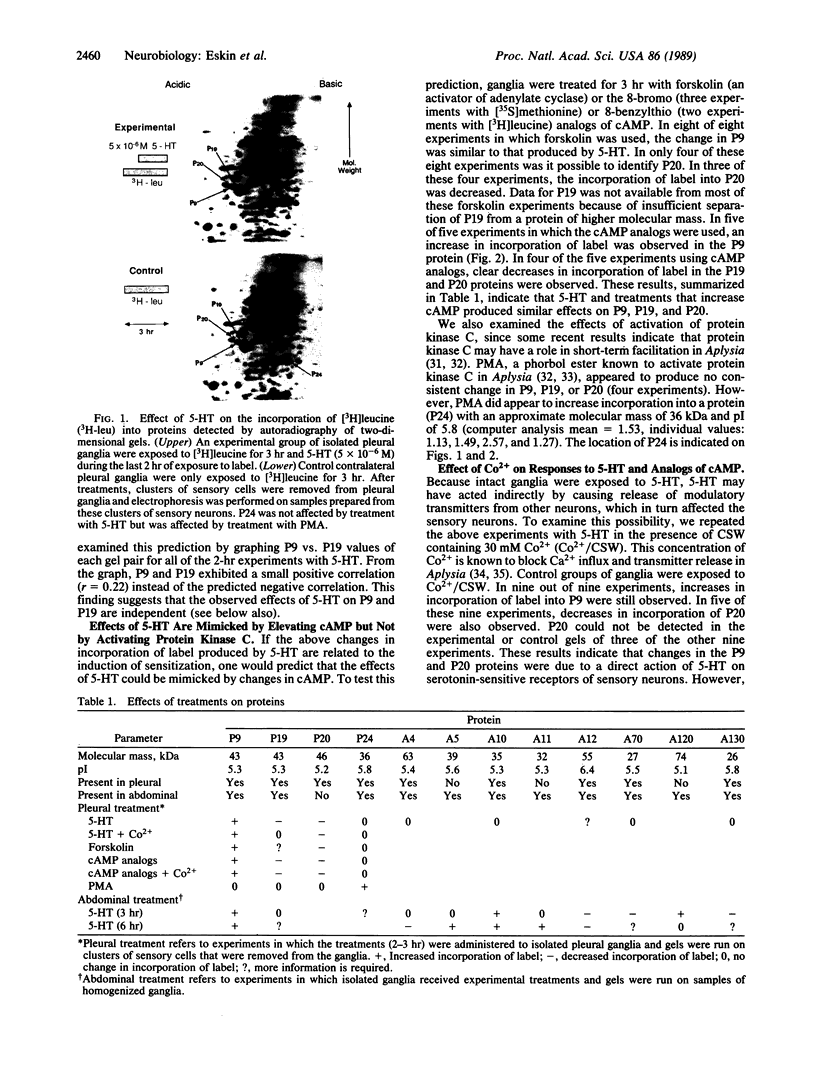
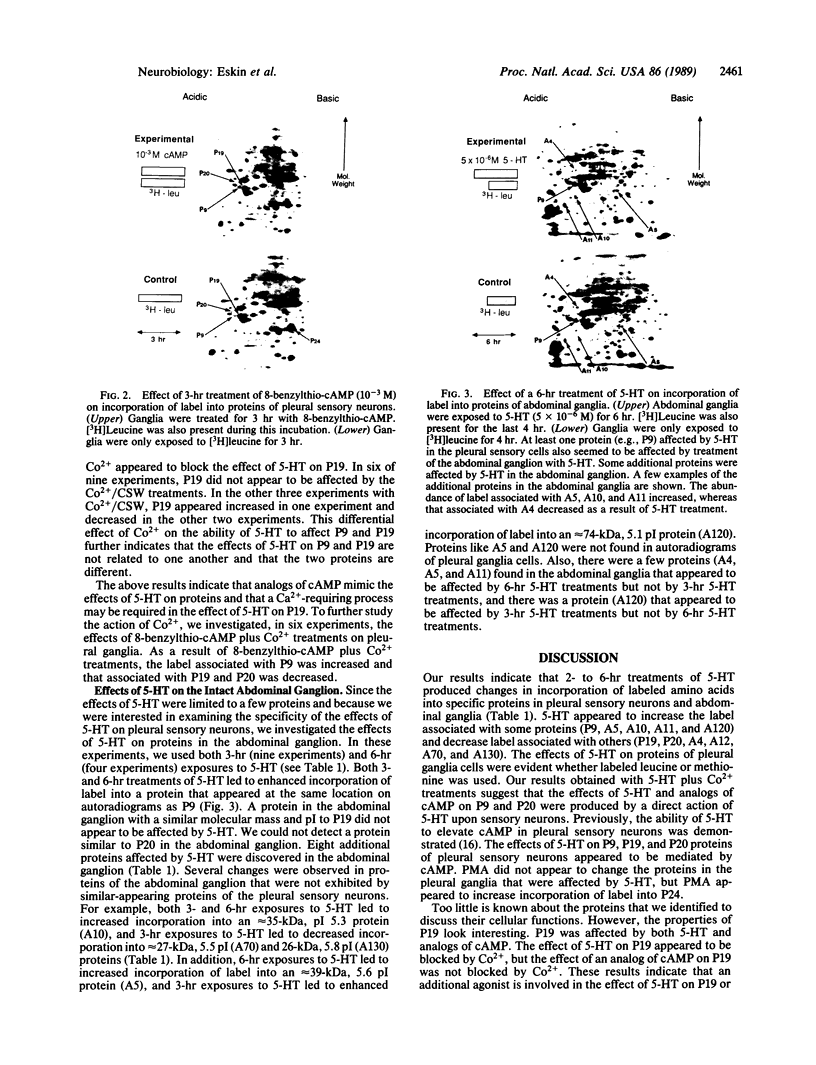
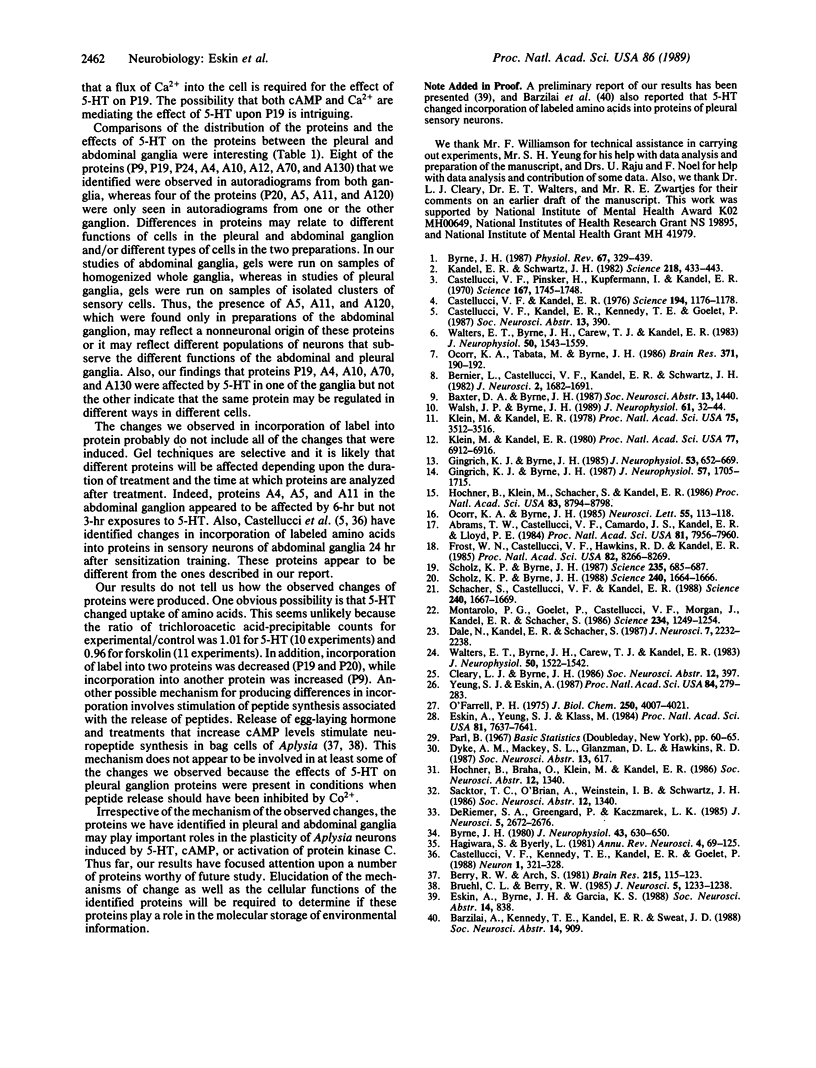
Images in this article
Selected References
These references are in PubMed. This may not be the complete list of references from this article.
- Abrams T. W., Castellucci V. F., Camardo J. S., Kandel E. R., Lloyd P. E. Two endogenous neuropeptides modulate the gill and siphon withdrawal reflex in Aplysia by presynaptic facilitation involving cAMP-dependent closure of a serotonin-sensitive potassium channel. Proc Natl Acad Sci U S A. 1984 Dec;81(24):7956–7960. doi: 10.1073/pnas.81.24.7956. [DOI] [PMC free article] [PubMed] [Google Scholar]
- Bernier L., Castellucci V. F., Kandel E. R., Schwartz J. H. Facilitatory transmitter causes a selective and prolonged increase in adenosine 3':5'-monophosphate in sensory neurons mediating the gill and siphon withdrawal reflex in Aplysia. J Neurosci. 1982 Dec;2(12):1682–1691. doi: 10.1523/JNEUROSCI.02-12-01682.1982. [DOI] [PMC free article] [PubMed] [Google Scholar]
- Berry R. W., Arch S. Activation of neurosecretory cells enhances their synthesis of secretory protein. Brain Res. 1981 Jun 29;215(1-2):115–123. doi: 10.1016/0006-8993(81)90495-9. [DOI] [PubMed] [Google Scholar]
- Bruehl C. L., Berry R. W. Regulation of synthesis of the neurosecretory egg-laying hormone of Aplysia: antagonistic roles of calcium and cyclic adenosine 3':5'-monophosphate. J Neurosci. 1985 May;5(5):1233–1238. doi: 10.1523/JNEUROSCI.05-05-01233.1985. [DOI] [PMC free article] [PubMed] [Google Scholar]
- Byrne J. H. Analysis of ionic conductance mechanisms in motor cells mediating inking behavior in Aplysia californica. J Neurophysiol. 1980 Mar;43(3):630–650. doi: 10.1152/jn.1980.43.3.630. [DOI] [PubMed] [Google Scholar]
- Byrne J. H. Cellular analysis of associative learning. Physiol Rev. 1987 Apr;67(2):329–439. doi: 10.1152/physrev.1987.67.2.329. [DOI] [PubMed] [Google Scholar]
- Castellucci V. F., Kennedy T. E., Kandel E. R., Goelet P. A quantitative analysis of 2-D gels identifies proteins in which labeling is increased following long-term sensitization in Aplysia. Neuron. 1988 Jun;1(4):321–328. doi: 10.1016/0896-6273(88)90080-3. [DOI] [PubMed] [Google Scholar]
- Castellucci V., Kandel E. R. Presynaptic facilitation as a mechanism for behavioral sensitization in Aplysia. Science. 1976 Dec 10;194(4270):1176–1178. doi: 10.1126/science.11560. [DOI] [PubMed] [Google Scholar]
- Castellucci V., Pinsker H., Kupfermann I., Kandel E. R. Neuronal mechanisms of habituation and dishabituation of the gill-withdrawal reflex in Aplysia. Science. 1970 Mar 27;167(3926):1745–1748. doi: 10.1126/science.167.3926.1745. [DOI] [PubMed] [Google Scholar]
- Dale N., Kandel E. R., Schacher S. Serotonin produces long-term changes in the excitability of Aplysia sensory neurons in culture that depend on new protein synthesis. J Neurosci. 1987 Jul;7(7):2232–2238. doi: 10.1523/JNEUROSCI.07-07-02232.1987. [DOI] [PMC free article] [PubMed] [Google Scholar]
- DeRiemer S. A., Greengard P., Kaczmarek L. K. Calcium/phosphatidylserine/diacylglycerol-dependent protein phosphorylation in the Aplysia nervous system. J Neurosci. 1985 Oct;5(10):2672–2676. doi: 10.1523/JNEUROSCI.05-10-02672.1985. [DOI] [PMC free article] [PubMed] [Google Scholar]
- Eskin A., Yeung S. J., Klass M. R. Requirement for protein synthesis in the regulation of a circadian rhythm by serotonin. Proc Natl Acad Sci U S A. 1984 Dec;81(23):7637–7641. doi: 10.1073/pnas.81.23.7637. [DOI] [PMC free article] [PubMed] [Google Scholar]
- Frost W. N., Castellucci V. F., Hawkins R. D., Kandel E. R. Monosynaptic connections made by the sensory neurons of the gill- and siphon-withdrawal reflex in Aplysia participate in the storage of long-term memory for sensitization. Proc Natl Acad Sci U S A. 1985 Dec;82(23):8266–8269. doi: 10.1073/pnas.82.23.8266. [DOI] [PMC free article] [PubMed] [Google Scholar]
- Gingrich K. J., Byrne J. H. Simulation of synaptic depression, posttetanic potentiation, and presynaptic facilitation of synaptic potentials from sensory neurons mediating gill-withdrawal reflex in Aplysia. J Neurophysiol. 1985 Mar;53(3):652–669. doi: 10.1152/jn.1985.53.3.652. [DOI] [PubMed] [Google Scholar]
- Gingrich K. J., Byrne J. H. Single-cell neuronal model for associative learning. J Neurophysiol. 1987 Jun;57(6):1705–1715. doi: 10.1152/jn.1987.57.6.1705. [DOI] [PubMed] [Google Scholar]
- Hagiwara S., Byerly L. Calcium channel. Annu Rev Neurosci. 1981;4:69–125. doi: 10.1146/annurev.ne.04.030181.000441. [DOI] [PubMed] [Google Scholar]
- Hochner B., Klein M., Schacher S., Kandel E. R. Additional component in the cellular mechanism of presynaptic facilitation contributes to behavioral dishabituation in Aplysia. Proc Natl Acad Sci U S A. 1986 Nov;83(22):8794–8798. doi: 10.1073/pnas.83.22.8794. [DOI] [PMC free article] [PubMed] [Google Scholar]
- Kandel E. R., Schwartz J. H. Molecular biology of learning: modulation of transmitter release. Science. 1982 Oct 29;218(4571):433–443. doi: 10.1126/science.6289442. [DOI] [PubMed] [Google Scholar]
- Klein M., Kandel E. R. Mechanism of calcium current modulation underlying presynaptic facilitation and behavioral sensitization in Aplysia. Proc Natl Acad Sci U S A. 1980 Nov;77(11):6912–6916. doi: 10.1073/pnas.77.11.6912. [DOI] [PMC free article] [PubMed] [Google Scholar]
- Klein M., Kandel E. R. Presynaptic modulation of voltage-dependent Ca2+ current: mechanism for behavioral sensitization in Aplysia californica. Proc Natl Acad Sci U S A. 1978 Jul;75(7):3512–3516. doi: 10.1073/pnas.75.7.3512. [DOI] [PMC free article] [PubMed] [Google Scholar]
- Montarolo P. G., Goelet P., Castellucci V. F., Morgan J., Kandel E. R., Schacher S. A critical period for macromolecular synthesis in long-term heterosynaptic facilitation in Aplysia. Science. 1986 Dec 5;234(4781):1249–1254. doi: 10.1126/science.3775383. [DOI] [PubMed] [Google Scholar]
- O'Farrell P. H. High resolution two-dimensional electrophoresis of proteins. J Biol Chem. 1975 May 25;250(10):4007–4021. [PMC free article] [PubMed] [Google Scholar]
- Ocorr K. A., Byrne J. H. Membrane responses and changes in cAMP levels in Aplysia sensory neurons produced by serotonin, tryptamine, FMRFamide and small cardioactive peptideB (SCPB). Neurosci Lett. 1985 Apr 9;55(2):113–118. doi: 10.1016/0304-3940(85)90004-7. [DOI] [PubMed] [Google Scholar]
- Ocorr K. A., Tabata M., Byrne J. H. Stimuli that produce sensitization lead to elevation of cyclic AMP levels in tail sensory neurons of Aplysia. Brain Res. 1986 Apr 16;371(1):190–192. doi: 10.1016/0006-8993(86)90828-0. [DOI] [PubMed] [Google Scholar]
- Schacher S., Castellucci V. F., Kandel E. R. cAMP evokes long-term facilitation in Aplysia sensory neurons that requires new protein synthesis. Science. 1988 Jun 17;240(4859):1667–1669. doi: 10.1126/science.2454509. [DOI] [PubMed] [Google Scholar]
- Scholz K. P., Byrne J. H. Intracellular injection of cAMP induces a long-term reduction of neuronal K+ currents. Science. 1988 Jun 17;240(4859):1664–1666. doi: 10.1126/science.2837826. [DOI] [PubMed] [Google Scholar]
- Scholz K. P., Byrne J. H. Long-term sensitization in Aplysia: biophysical correlates in tail sensory neurons. Science. 1987 Feb 6;235(4789):685–687. doi: 10.1126/science.2433766. [DOI] [PubMed] [Google Scholar]
- Walsh J. P., Byrne J. H. Modulation of a steady-state Ca2+-activated, K+ current in tail sensory neurons of Aplysia: role of serotonin and cAMP. J Neurophysiol. 1989 Jan;61(1):32–44. doi: 10.1152/jn.1989.61.1.32. [DOI] [PubMed] [Google Scholar]
- Walters E. T., Byrne J. H., Carew T. J., Kandel E. R. Mechanoafferent neurons innervating tail of Aplysia. I. Response properties and synaptic connections. J Neurophysiol. 1983 Dec;50(6):1522–1542. doi: 10.1152/jn.1983.50.6.1522. [DOI] [PubMed] [Google Scholar]
- Walters E. T., Byrne J. H., Carew T. J., Kandel E. R. Mechanoafferent neurons innervating tail of Aplysia. II. Modulation by sensitizing stimulation. J Neurophysiol. 1983 Dec;50(6):1543–1559. doi: 10.1152/jn.1983.50.6.1543. [DOI] [PubMed] [Google Scholar]
- Yeung S. J., Eskin A. Involvement of a specific protein in the regulation of a circadian rhythm in Aplysia eye. Proc Natl Acad Sci U S A. 1987 Jan;84(1):279–283. doi: 10.1073/pnas.84.1.279. [DOI] [PMC free article] [PubMed] [Google Scholar]



